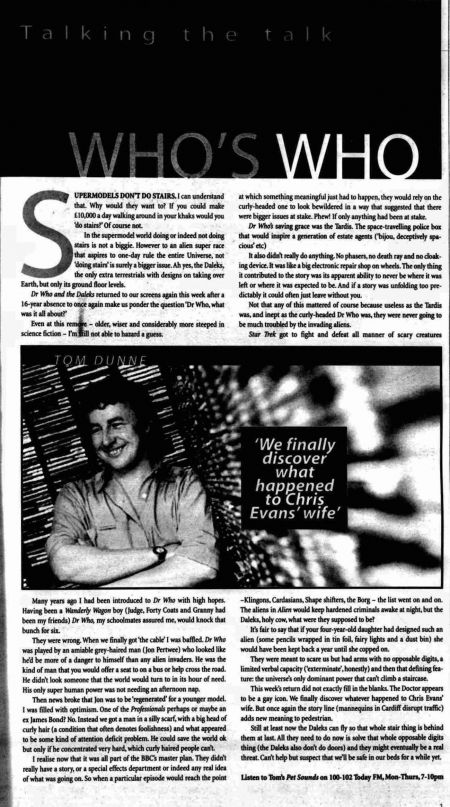Who's Who (2005)
- Publication: Evening Herald
- Date: 2005-04-01
- Author: Tom Dunne
- Page: 23
- Language: English
SUPERMODELS DON'T DO STAIRS. I can understand that. Why would they want to? If you could make £10,000 a day walking around in your khaks would you 'do stairs? Of course not.
In the supermodel world doing or indeed not doing stairs is not a biggie. However to an alien super race that aspires to one-day rule the entire Universe, not 'doing stairs' is surely a bigger issue. All yes, the Daleks, the only extra terrestrials with designs on taking over Earth, but only its ground floor levels.
Dr Who and the Daleks returned to our screens again this week after a 16-year absence to once again make us ponder the question 'Dr Who, what was it all about?'
Even at this remove - older, wiser and considerably more steeped in science fiction - I'm still not able to hazard a guess.
Many years ago I had been introduced to Dr Who with high hopes. Having been a Wanderly Wagon boy (fudge, Forty Coats and Granny had been my friends) Dr Who, my schoolmates assured me, would knock that bunch for six.
They were wrong. When we finally got 'the cable' I was baffled. Dr Who was played by an amiable grey-haired man (Jon Pertwee) who looked like he'd be more of a danger to himself than any alien invaders. He was the kind of man that you would offer a seat to on a bus or help cross the road. He didn't look someone that the world would turn to in its hour of need. His only super human power was not needing an afternoon nap.
Then news broke that Jon was to be 'regenerated' for a younger model. I was filled with optimism. One of the Professionals perhaps or maybe an ex James Bond? No. Instead we got a man in a silly scarf, with a big head of curly hair (a condition that often denotes foolishness) and what appeared to be some kind of attention deficit problem. He could save the world ok but only if he concentrated very hard, which curly haired people can't.
I realise now that it was all part of the BBC's master plan. They didn't really have a story, or a special effects department or indeed any real idea of what was going on. So when a particular episode would reach the point at which something meaningful just had to happen, they would rely on the curly-headed one to look bewildered in a w y that suggested that there were bigger issues at stake. Phew! If only anything had been at stake.
Dr Who's saving grace was the Tardis. The space-travelling police box that would inspire a generation of estate agents ('bijou, deceptively spacious' etc)
It also didn't really do anything. No phasers, no death ray and no cloaking device. It was like a big electronic repair shop on wheels. The only thing it contributed to the story was its apparent ability to never be where it was left or where it was expected to be. And if a story was unfolding too predictably it could often just leave without you.
Not that any of this mattered of course because useless as the Tardis was, and inept as the curly-headed Dr Who was, they were never going to be much troubled by the invading aliens.
Star Trek got to fight and defeat all manner of scary creatures - Klingons, Cardasians, Shape shifters, the Borg - the list went on and on. The aliens in Alien would keep hardened criminals awake at night, but the Daleks, holy cow, what were they supposed to be?
It's fair to say that if your four-year-old daughter had designed such an alien (some pencils wrapped in tin foil, fairy lights and a dust bin) she would have been kept back a year until she copped on.
They were meant to scare us but had alms with no opposable digits, a limited verbal capacity ('exterminate, honestly) and then that defining feature: the universe's only dominant power that can't climb a staircase.
This week's return did not exactly fill in the blanks. The Doctor appears to be a gay icon. We finally discover whatever happened to Chris Evans' wife. But once again the story line (mannequins in Cardiff disrupt traffic) adds new meaning to pedestrian.
Still at least now the Daleks can fly so that whole stair thing is behind them at last. All they need to do now is solve that whole opposable digits thing (the Nicks also don't do doors) and they might eventually be a real threat. Can't help but suspect that we'll be safe in our beds for a while yet.
Listen to Tom's Pet Sounds on 100-102 Today FM, Mon-Thur, 7.10pm
Disclaimer: These citations are created on-the-fly using primitive parsing techniques. You should double-check all citations. Send feedback to whovian@cuttingsarchive.org
- APA 6th ed.: Dunne, Tom (2005-04-01). Who's Who (2005). Evening Herald p. 23.
- MLA 7th ed.: Dunne, Tom. "Who's Who (2005)." Evening Herald [add city] 2005-04-01, 23. Print.
- Chicago 15th ed.: Dunne, Tom. "Who's Who (2005)." Evening Herald, edition, sec., 2005-04-01
- Turabian: Dunne, Tom. "Who's Who (2005)." Evening Herald, 2005-04-01, section, 23 edition.
- Wikipedia (this article): <ref>{{cite news| title=Who's Who (2005) | url=http://cuttingsarchive.org/index.php/Who%27s_Who_(2005) | work=Evening Herald | pages=23 | date=2005-04-01 | via=Doctor Who Cuttings Archive | accessdate=27 April 2024 }}</ref>
- Wikipedia (this page): <ref>{{cite web | title=Who's Who (2005) | url=http://cuttingsarchive.org/index.php/Who%27s_Who_(2005) | work=Doctor Who Cuttings Archive | accessdate=27 April 2024}}</ref>
